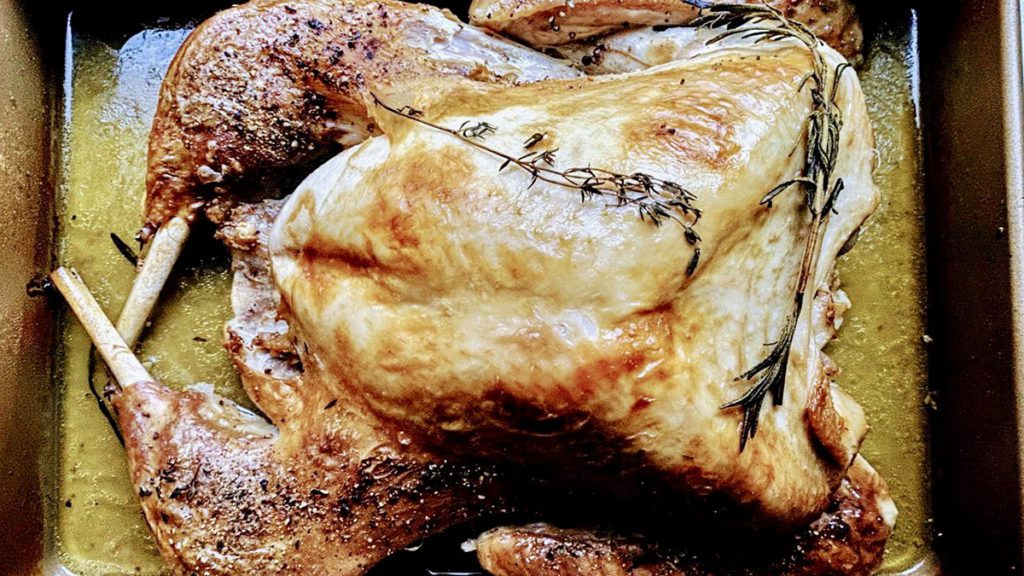Chef Nigel Spence’s Recipe for a No-Fail Holiday Turkey
Rather than bore you with only the latest recipe for this year’s turkey, I will simply pull back the curtains and guide you with all the tips and tricks that I have used over the years in the restaurant to quickly and effortlessly produce great roasted birds for the holiday table. These tips minimize the possibilities of failure and maximizes simplicity in technique and execution. It also makes it easy to scale up your operation to feed the masses if you are called on for bird duty. You can certainly add any additional techniques you may have learned over the years to these guidelines, but understand that the purpose of this exercise is to yield a great tasting bird with minimal time and effort, so I am keeping it bare bones (pardon the pun).
First and foremost, spatchcocking the bird is a must in the interest of time, effort and evenly cooking the meat. You may never cook a turkey (or chicken) whole again after you try this technique.
Spatchcocking is a fancy way of saying butterflying and simply means cutting out the backbone of the bird, pushing down on the breast plate to flatten it out for more even cooking. That said the backbone will not at all be wasted, but rather truly become the foundation of flavor for your turkey stock along with the few supporting giblets that may or may not be included in the cavity of your bird. That stock will ultimately become your holy gravy, once it reduces in volume and the flavor gets concentrated with the addition of the drippings from the pan of the cooked turkey.
Always start the stock first, as soon as you locate the giblets from the inside of the bird, so that by the time you are done butchering, cleaning and seasoning your bird or birds, the stock will be halfway done. Keep adding the parts you cut off to the stock as you go along, rather than waiting till you have done all the butchering. That saves a lot of time. I prefer to discard the liver as I am not a fan and I believe it contributes an off taste to the resulting stock. That statement can create hours of debate amongst chefs. I love fried chicken liver. I hate chicken liver in my stock. I hate turkey liver fried OR in my stock. End of the story there for me personally.
Chop the backbone and the neck (if it was included) in half to make it easier to fit in the stockpot and add it in with whatever other giblets were found hanging out in the cavity of the bird when it defrosted.
REMOVE THE WISHBONE FROM THE TURKEY
Whenever I roast whole chickens or turkeys, I always remove the wishbone to facilitate easier carving when the bird is done. Removing the wishbone from a turkey requires a little more effort than for a chicken simply due to the much larger size of bones and tendons attached, but it is well worth the effort when its time to carve the bird without that obstruction.
Pull the skin back from the front side of the breast, revealing the wishbone running down on both sides of the neck cavity. With the tip of a sharp knife gently cut along both sides of the two prongs of the wishbone. Work your knife (or finger) around, under and along the length of the bone separating it from the meat. Cut around all three points of attachment and lift the wishbone out. At this point you should be able to simply pull it out. It may take a bit of effort if any of the tendons are still attached, but a good tug and it will give. Add the bone to your stock.
CHOP THE ANKLES OFF
No, we are not recreating a scene from the movie Misery, but rather simply facilitating easy removal of the tendons in the turkey legs once they are fully cooked.
I don’t think turkeys really have ankles, and if they did and I had to be anatomically correct, I would venture to say that it would actually be closer to the feet!
Anyway, I simply chop off the little nubs at the bottom of the drumstick where the tough inedible ligaments running through the legs attach to the base of the drumstick. This effectively severs the connection of those ligaments and tendons, and as the turkey roasts in the oven, the skin shrinks back to reveal the ends of these tendons that can now easily be pulled out once the bird has been roasted to proper temperature. No more fighting with these tough tendons while trying to enjoy that hungry bite into the juicy drumstick.
CUT A SMALL INCISION UNDER BOTH LEGS AND WING JOINTS
Spatchcocking is only half the battle to achieve more even cooking, especially for birds on the larger side. The joint connecting the drumstick to the thigh is notorious for being a bit undercooked, as is the joint where the wing connects with the body of the bird. For that reason, I cut a small incision into the articulation between these two joints to facilitate getting more heat in the space for more even cooking. I make the small incision on the underside of the bird so it is not noticeable when the bird is sitting breast side up for carving.
SPATCHCOCKING THE TURKEY:
To spatchcock a turkey, turn the turkey breast-side down and cut along both sides of the backbone preferably using kitchen shears to remove it. Be very careful if using a knife, because the pressure exerted using a knife to cut through the bones can quickly cause an accident. At least have a SHARP and large chef’s knife to do the job well. Then, turn the bird breast-side up and push on the breastbone until you hear it crack. Pull the thighs outward so turkey lies flat and tuck the wing tips under the back. That’s it! You have successfully completed the small but effective technique bearing the most interesting name.
SEASONING THE TURKEY
I personally believe that turkey has such a distinct and unique flavor, that I tend to stay away from strong seasonings that compete with it. My favorite seasoning is simply garlic salt along with the support of a couple of aromatics such as thyme and rosemary. Many do not subscribe to my theory, and over the years I too was known to adorn my birds with jerk seasoning and other exotics, but after roasting countless birds over many occasions with untold amounts of varying seasonings – successes and failures – I stand my ground on my convictions about turkey simply allowing the turkeys flavor to speak up. I like a simple coarse salt flavored with garlic or any other aromatic. I sometimes substitute regular unflavored salt, smoked salt, scotch bonnet pepper salt, onion salt, or any other mild flavored salt. Be sure to lift the skin on the breast and legs and thighs and get the salt in between the skin and the meat, being careful not to tear the skin to facilitate a better presentation at the table. You may also add a few leaves of rosemary and thyme under the skin.
I don’t find a need to rub salt on the inside of the cavity, nor do I stuff the cavity with any vegetables or herbs, but again, that is my preference. Feel free to do all those things if you so desire. By simply allowing the bird to sit overnight in the fridge uncovered after seasoning generously with the salt, you will have successfully dry salt brined the bird, which yields tastier and better textured meat. This step is also optional, but it makes such a difference that I do my best to make it happen when time allows.
GIVE THE TURKEY A SUPERMAN CAPE FOR HANDS FREE BASTING
This technique takes all the work out of basting your bird.
The bird cooks and bastes itself all at the same time!
Soak a large piece of cheesecloth in melted, salted butter and lemon juice.
Drape the soaked cloth over the turkey and cook the turkey with the blanket of butter This will keep it moist and infuse flavor, minimize burn spots and create a delightful caramel color on the finish. Remove the cloth 20 minutes prior to being done to further brown any spots that need more color. I prefer a light brown hue with a few darker spots rather than a uniform dark brown.
FIXING AN OVERDONE TURKEY
A perfectly cooked turkey should be removed from the oven when the breast meat hits 155°F and the leg 160°F on an instant-read thermometer. There will also be carryover cooking that’s going to take the temperature a few degrees higher even after sitting outside the oven, since your bird should rest for at least 20 minutes before carving and serving.
Unfortunately, the best laid plans of mice and men often go awry. With all the family and screaming kids on Thanksgiving Day, things don’t always go according to how you imagined it when you took on the task of feeding the masses. If you screw up the main event, sometimes there is a way to recover if it didn’t char to a crisp.
Heat the turkey or chicken stock and bring to a simmer. Slice the meat and put it on a pre warmed platter that has a shallow bowl shape on the bottom and ladle the hot broth over the meat. The slices will absorb the broth and rehydrate. The warmer it is the more palatable it becomes. No one will ever know that you were freaking out in the kitchen!
INGREDIENTS:
12–18-pound Turkey, butchered and giblets reserved
2 tablespoons coarse Garlic salt
Couple sprigs of Thyme
Couple sprigs of Rosemary
½ tablespoon Cornstarch (optional)
½ cup Butter, melted
Juice of 1 Lemon, fresh squeezed
Cheesecloth, folded over to create at least 4 layers (about 20 inches worth)
2 cups Turkey gravy (recipe follows)
METHOD:
Tuck the wing tips under the turkey and place breast side up on a flat rack inside a roasting pan. Flatten out the bird as much as possible and make sure the legs are skin side up and lying flat. Soak cheesecloth in the melted butter mixture and drape it over the whole bird. You may add a sprig of thyme and rosemary to the breast under the cheesecloth for additional flavor. Add 1 cup of water in the roasting pan to keep the oven steamy during cooking and to have some natural dripping left over to add to your stock for the gravy. The longer your turkey takes to cook, the more liquid you will need. If the liquid is almost gone before the turkey is done cooking, add more water or chicken stock so the drippings in the pan do not burn. Roast at 450°F for about 1-1¼ hours, until thickest part of the thigh reaches 160 degrees and breast meat reaches 155 degrees Fahrenheit. Remove the cheesecloth about 20 minutes before the bird will be done to facilitate more browning if necessary. Be aware that if your marinade or seasoning has sugar, the turkey will brown faster. Cooking times vary greatly based on the size of the bird and the water content from brining at the factory, so a thermometer is the key to success. A thermometer that is oven safe to keep inside the bird while cooking is the ultimate game changer for worry free roasting. Though you may be tempted to add other items to the oven to share cooking space with the turkey, I advise against it as it can change cooking times greatly. Turkeys don’t like when you multitask in their space. When the bird is done, remove it from the oven and pull on the tendons that should now be sticking out from the drumsticks. If they give a lot of difficulty to remove, it means your bird needs more time in the oven.
Let the bird rest for 20 minutes before carving. There are a zillion videos on carving so I rather not bore anyone with a description, but you will be happy to know that it will be a much easier task with the wishbone and the tendons from the drumsticks already removed.
MAKING THE TURKEY STOCK AND GRAVY
Make a turkey stock with the giblets, backbone, wishbone and drumstick ends.
Add all to stockpot and cover with cold water 4 inches above the meat and bones.
Simmer over medium low heat for just over an hour. Strain and discard all meat and bones. You have successfully made the turkey stock. Add the pan drippings from the cooked turkey and add a sprig of thyme and rosemary then simmer for 15 minutes over medium low heat. Check for salt and “herby” flavor and adjust to your liking. You have successfully made turkey gravy. The gravy should be salty for adorning the meat. I love natural gravy that is on the thinner side, but if you prefer your gravy thicker, add a slurry of 1/2 tablespoon cornstarch to 1 tablespoon cold water in a cup and stir till combined without lumps, then whisk it into the gravy and heat again till thickened.
If you plan to make your stock the day before you roast the turkey, then you have the opportunity to make a deeper, more complex flavored gravy by simply leaving the meat and bones in the stock while it cools, then refrigerate overnight without straining. Reheat the next day, strain and add aromatics, pan drippings and salt (if needed).
Happy Thanksgiving!
Nigel Spence, a Culinary Institute of America alumnus, was born in Kingston, Jamaica. Nigel freelanced at the Television Food Network for 3 years where he worked with culinary luminaries such as Bobby Flay and Emeril Lagasse. Chef Spence has appeared twice on Throwdown with Bobby Flay where he emerged the victor in cook offs against the Food Network star and was featured on CBS when he appeared on Tony’s Table as well as ABC’s Neighborhood Eats, NBC’s The Today Show , Sirius’ Everyday Living with Martha Stewart and TVFN’s Chopped. The acclaimed and New York Times-reviewed Ripe Kitchen and Bar is Mr Spence’s first entrepreneurial endeavor.







